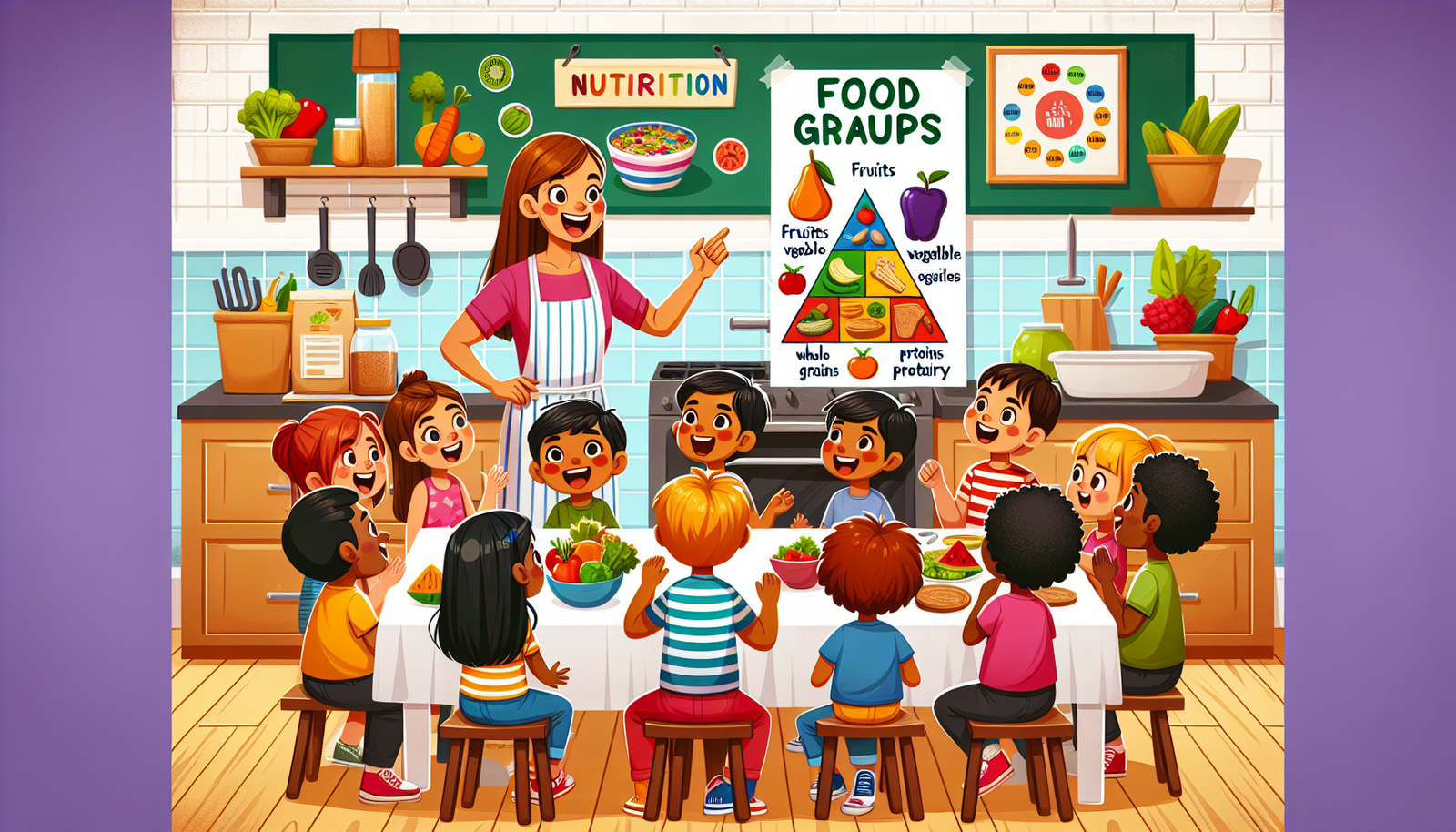
How to Teach Kids About a Balanced Diet
Teaching kids about a balanced diet is crucial for nurturing healthy eating habits early on. Studies show that children with knowledge of nutrition are more likely to make healthier food choices throughout life. This article will guide you through effective methods for introducing concepts of nutrition, food groups, and portion control to young learners. By incorporating fun activities and interactive lessons, you can engage kids and help them understand the importance of maintaining a balanced diet. Discover strategies and tips for fostering a supportive learning environment that encourages kids to make informed dietary decisions.
Understanding the Basics of a Balanced Diet for Kids
Feeding children a balanced diet is crucial for their growth and development. It’s about more than just filling their bellies. It requires providing the right nutrients in the right amounts. By understanding what makes a diet balanced, parents and guardians can support their children’s health and well-being effectively.
Key Nutrients Necessary for Children’s Growth and Development
Children need a variety of nutrients in their diet to grow and thrive. These nutrients play unique roles in their bodies and contribute to overall health.
- Proteins: Essential for building and repairing tissues. They are the building blocks of muscles, organs, and the immune system. Sources include meat, eggs, dairy products, beans, and nuts.
- Carbohydrates: The primary energy source for children. Carbs fuel their daily activities and support brain function. Whole grains, fruits, and vegetables are excellent sources.
- Fats: Not all fats are bad. Healthy fats support brain development and absorb fat-soluble vitamins. Avocados, nuts, and fish like salmon provide healthy fats.
- Vitamins and Minerals: Vital for immune function, bone health, and energy production. Calcium, vitamin D, iron, and vitamin C are particularly important. Dairy, leafy greens, fruits, and fortified cereals can help meet these needs.
- Fiber: Supports digestive health and prevents constipation. Whole grains, fruits, and vegetables provide necessary fiber.
Incorporating these nutrients into daily meals helps ensure children receive the nutrition they need for optimal growth.
Food Groups Essential for Children’s Health
A balanced diet doesn’t just focus on individual nutrients. It involves understanding the food groups and their roles in a child’s diet. Each group offers unique benefits.
- Fruits and Vegetables: Packed with vitamins, minerals, and fiber. Encourage a colorful plate for a diverse nutrient intake.
- Grains: Provide energy through carbohydrates. Opt for whole grains like brown rice and whole wheat bread for added fiber and nutrients.
- Proteins: Vital for growth and development. Include a variety of sources such as lean meats, beans, and nuts.
- Dairy: Important for bone health due to calcium and vitamin D. Milk, yogurt, and cheese are great sources.
- Fats and Oils: Essential for brain health. Choose healthy options like olive oil and avocados.
Balancing these food groups in their diet ensures children get a wide range of nutrients necessary for their health.
The Role of Portion Control in a Child’s Diet
Portion control is key in preventing overeating and ensuring balanced nutrition. Children have smaller stomachs than adults, and their portion sizes should reflect that.
- Understanding Portions: Use visual cues like a child’s hand size to determine appropriate portions. A serving of protein should be about the size of their palm, while fruits and vegetables can fill half the plate.
- Mindful Eating: Encourage children to listen to their hunger cues. Eating slowly allows them to recognize when they’re full.
- Balanced Meals: Ensure each meal includes appropriate portions from different food groups. This approach promotes satiety and provides necessary nutrients.
- Avoiding Empty Calories: Limit sugary snacks and drinks that provide calories without nutritional value. Offer healthy alternatives like fruit or yogurt.
Teaching children about portion control from a young age promotes healthy eating habits that can last a lifetime.
Creative Ways to Educate Kids About Nutrition
Engaging children in learning about nutrition can be fun and rewarding. By making nutrition education interactive, kids can develop a positive relationship with food. This section explores creative methods to teach children about healthy eating.
Fun Activities to Teach Kids About Healthy Eating
Interactive activities are great for keeping children interested in nutrition. These activities not only educate but also entertain.
- Food Art: Create art using fruits and vegetables. This activity encourages kids to explore new foods in a fun way.
- Taste Tests: Organize taste tests to introduce new foods. Encourage children to describe the flavors and textures.
- Garden Projects: Plant a small garden with your child. Growing their own food can increase their interest in eating fruits and vegetables.
- Cooking Classes: Host simple cooking classes. Kids can learn about ingredients and how to prepare healthy meals.
These activities make learning about nutrition enjoyable and memorable for children.
Storybooks and Games That Promote Nutritional Awareness
Storybooks and games can be powerful tools for teaching children about nutrition. They make complex concepts accessible and engaging.
- Nutritional Storybooks: Books with themes about healthy eating can convey important messages. Characters and stories can model positive food choices.
- Educational Games: Board games or apps focused on nutrition teach children about food groups and healthy habits. Interactive play reinforces learning.
- Role-Playing: Encourage children to act out scenes from stories. This activity deepens their understanding of nutritional concepts.
Integrating storybooks and games into learning provides a fun way for kids to absorb information.
How to Involve Kids in Meal Preparation for Better Learning
Involving children in meal preparation can enhance their understanding of nutrition. They learn about ingredients, cooking processes, and the importance of healthy eating.
- Age-Appropriate Tasks: Assign tasks based on the child’s age. Younger kids can wash vegetables, while older ones can help with chopping.
- Exploration: Allow children to explore different ingredients. Discuss their benefits and uses in meals.
- Recipe Selection: Let kids choose recipes for family meals. Encouraging them to pick nutritious options fosters decision-making skills.
- Cooking Demonstrations: Demonstrate cooking techniques. Show them how to measure ingredients and follow recipes.
Participating in meal preparation empowers children and instills a sense of responsibility towards healthy eating.
Overcoming Common Challenges in Promoting a Balanced Diet
Promoting a balanced diet can come with challenges. It’s important to address these obstacles with practical strategies. This section covers common issues such as picky eating and budget constraints, offering solutions to help families maintain nutritious eating habits.
Tips for Dealing with Picky Eaters
Dealing with picky eaters can be frustrating, but there are ways to encourage them to try new foods. The key is patience and creativity.
- Introduce New Foods Gradually: Start with small portions. Pair new foods with familiar favorites to make them less intimidating.
- Involve Them in Cooking: Children are more likely to try foods they helped prepare. Let them assist in the kitchen.
- Make Meals Fun: Use cookie cutters to create fun shapes. Presentation can make meals more appealing.
- Be a Role Model: Demonstrate healthy eating habits. Children often mimic their parents’ behaviors.
These tips can help turn mealtime into a positive experience for both children and parents.
How to Encourage Kids to Try New Foods
Encouraging children to try new foods can broaden their palate and improve their nutrition. It’s about making the experience enjoyable.
- Create a Positive Environment: Avoid pressuring children to eat. Offer new foods in a relaxed setting.
- Use Creative Naming: Give foods fun names. “Dinosaur broccoli” or “rocket carrots” can pique children’s curiosity.
- Reward System: Implement a reward system for trying new foods. Stickers or small incentives can motivate kids.
- Story Involvement: Relate foods to their favorite stories or characters. This connection can make them more willing to try.
Encouraging adventurous eating habits early on can lead to healthier choices in the future.
Strategies to Maintain a Nutritious Diet on a Budget
Maintaining a nutritious diet doesn’t have to be expensive. With the right strategies, families can eat healthily while staying within their budget.
- Plan Meals: Create a weekly meal plan. Planning prevents impulse buying and reduces waste.
- Buy in Bulk: Purchase non-perishable items in bulk. This approach saves money and ensures you have staples on hand.
- Seasonal Shopping: Buy fruits and vegetables in season. They’re often cheaper and fresher.
- Limit Processed Foods: Processed foods can be costly. Focus on whole foods that provide more nutrition for less money.
- DIY Snacks: Make snacks at home. Homemade granola bars or trail mix are healthier and more affordable than store-bought versions.
Implementing these strategies can make healthy eating accessible for every family.
Conclusion
Teaching kids about a balanced diet involves educating them on the importance of carbohydrates, proteins, fats, vitamins, and minerals. It’s crucial to explain how each food group contributes to their growth and overall health. Encouraging kids to eat a variety of foods helps them receive all necessary nutrients. Interactive activities and games can make learning about nutrition engaging for children. Involving them in meal planning and preparation fosters better eating habits.
FAQ
How can I teach my kids about the importance of a balanced diet?
Introduce them to colorful meals and explain the benefits of each food group. Use simple terms to describe how proteins, carbs, and veggies help their bodies grow and stay strong.
What are some fun activities to educate children on healthy eating habits?
Engage them in cooking simple recipes. Create a food rainbow chart where they can track different colors they eat. Organize taste tests with new fruits and vegetables.
What are the best resources for helping kids understand nutritional balance?
Children’s books on nutrition, educational videos, and interactive apps provide engaging ways to learn. Websites from trusted health organizations also offer valuable insights.
How can I encourage my child to make healthier food choices?
Set a good example by eating nutritious meals. Involve them in meal planning and grocery shopping. Praise their choices when they pick healthy snacks over sugary treats.
Why is it important for children to learn about balanced diets early?
Early knowledge helps them develop lifelong healthy habits. Understanding nutrition reduces the risk of obesity and ensures proper growth and development.
What are common challenges in teaching kids about nutrition, and how can I overcome them?
Picky eating and resistance to new foods are typical issues. Overcome these by offering a variety of options and involving them in meal preparations to make eating fun.











